Fruits are a vital part of a healthy diet, offering a rich source of vitamins, minerals, antioxidants, and dietary fiber. While all fruits have health benefits, some are particularly notable for their exceptional nutritional profiles. Here’s a list of some of the healthiest fruits based on their nutrient content and health benefits:
What are the healthiest fruits?
There are Top 12 healthiest fruits to eat according to the experts.
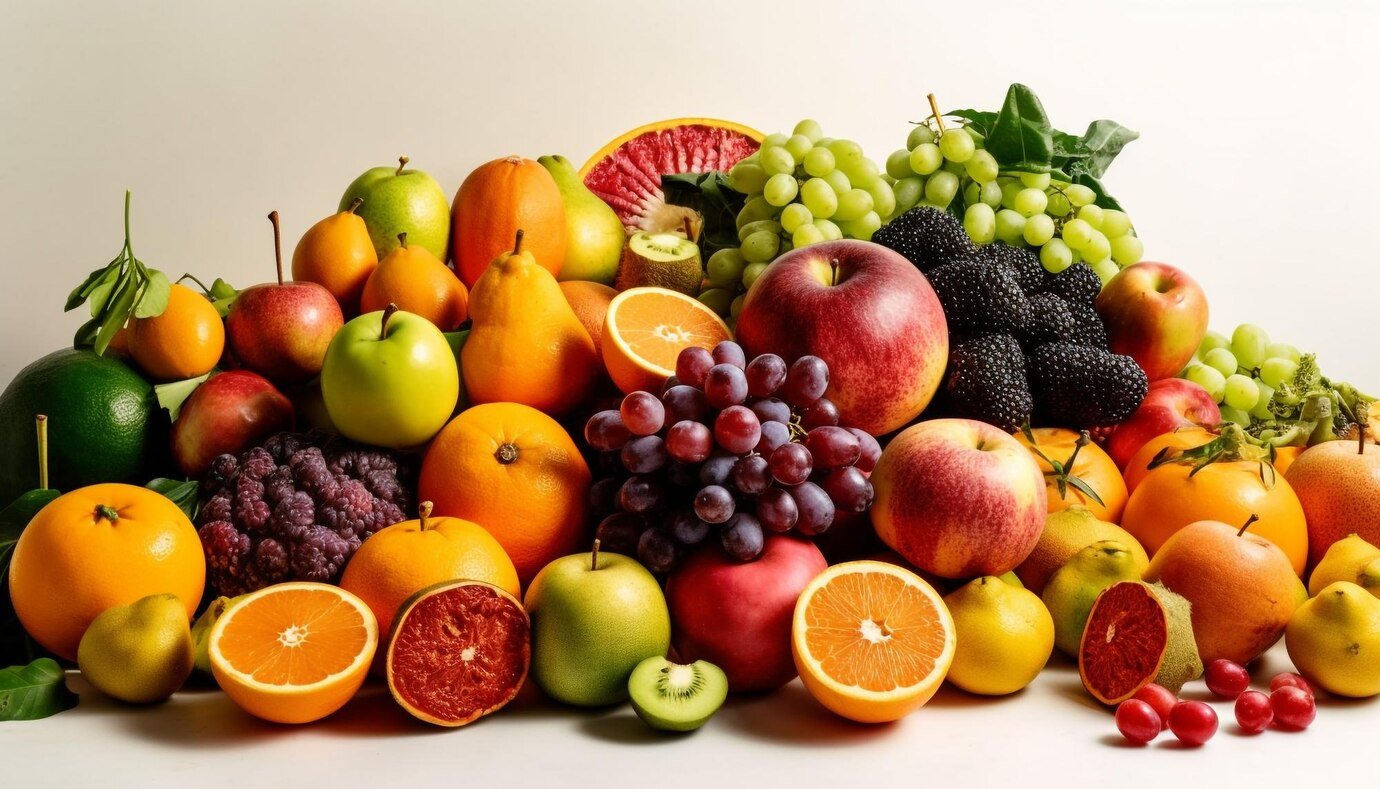
Table of Content
- Berries
- Apples
- Citrus Fruits
- Banana
- Kiwi
- Pomegranates
- Avocados
- Papayas
- Mangoes
- Watermelon
- Pineapple
- Cherries
- Berries: Strawberries, blueberries, raspberries, and blackberries are packed with antioxidants, vitamins, and fiber. They have been linked to a reduced risk of heart disease, cancer, and other inflammatory conditions.

Berries are small, soft, round fruit, typically bright in color and sweet or sour in taste. They are known for their high nutritional value, being rich in vitamins, minerals, fiber, and antioxidants. Here are some common types of berries and their health benefits:
Common Types of Berries
- Strawberries: These are rich in vitamin C, manganese, folate, and potassium. They are known for their bright red color and sweet flavor.
- Blueberries: Blueberries are high in antioxidants, particularly anthocyanins, which give them their blue color. They are also a good source of vitamins C and K and manganese.
- Raspberries: Raspberries contain high amounts of dietary fiber, vitamin C, vitamin K, and manganese. They have a sweet and slightly tart taste.
- Blackberries: Similar to raspberries, blackberries are high in fiber, vitamin C, and vitamin K. They are also rich in bioactive compounds that have antioxidant effects.
- Cranberries: Known for their tart taste, cranberries are high in vitamins C, E, and K1, as well as manganese and antioxidants.
- Acai Berries: Acai berries are small, dark purple berries rich in antioxidants, fiber, and heart healthy fats.
- Goji Berries: Also known as wolfberries, goji berries have a sweet tart flavor and are high in vitamins A and C, fiber, iron, and antioxidants.
Health Benefits of Berries
Antioxidant Rich: Berries are among the best sources of antioxidants, which can protect your cells from free radical damage and reduce inflammation.
Heart Health: Consuming berries has been linked to reduced risk factors for heart disease, including lower blood pressure and cholesterol levels.
Cancer Prevention: The antioxidants and anti-inflammatory properties of berries may lower the risk of certain types of cancer.
Improved Blood Sugar: Berries have a low glycemic index and high fiber content, which can help improve blood sugar and insulin response.
Skin Health: The vitamins and antioxidants in berries can contribute to healthy skin and reduce the signs of aging.
Digestive Health: The fiber in berries helps to maintain a healthy digestive system and prevent constipation.
Weight Management: Being low in calories yet high in fiber, berries can be a satisfying and healthy choice for those looking to manage or lose weight.
Incorporating a variety of berries into your diet is an excellent way to take advantage of their unique flavors and health benefits. They can be enjoyed fresh, frozen, dried, or in juice form, though fresh or frozen berries are generally preferred for their higher nutritional content. Adding berries to your diet is easy; include them in breakfast cereals, smoothies, salads, or simply enjoy them as a nutritious snack.
- Apples: High in fiber, vitamin C, and various antioxidants, apples are a great choice for a healthy snack. They have been linked to a reduced risk of heart disease, cancer, and diabetes.
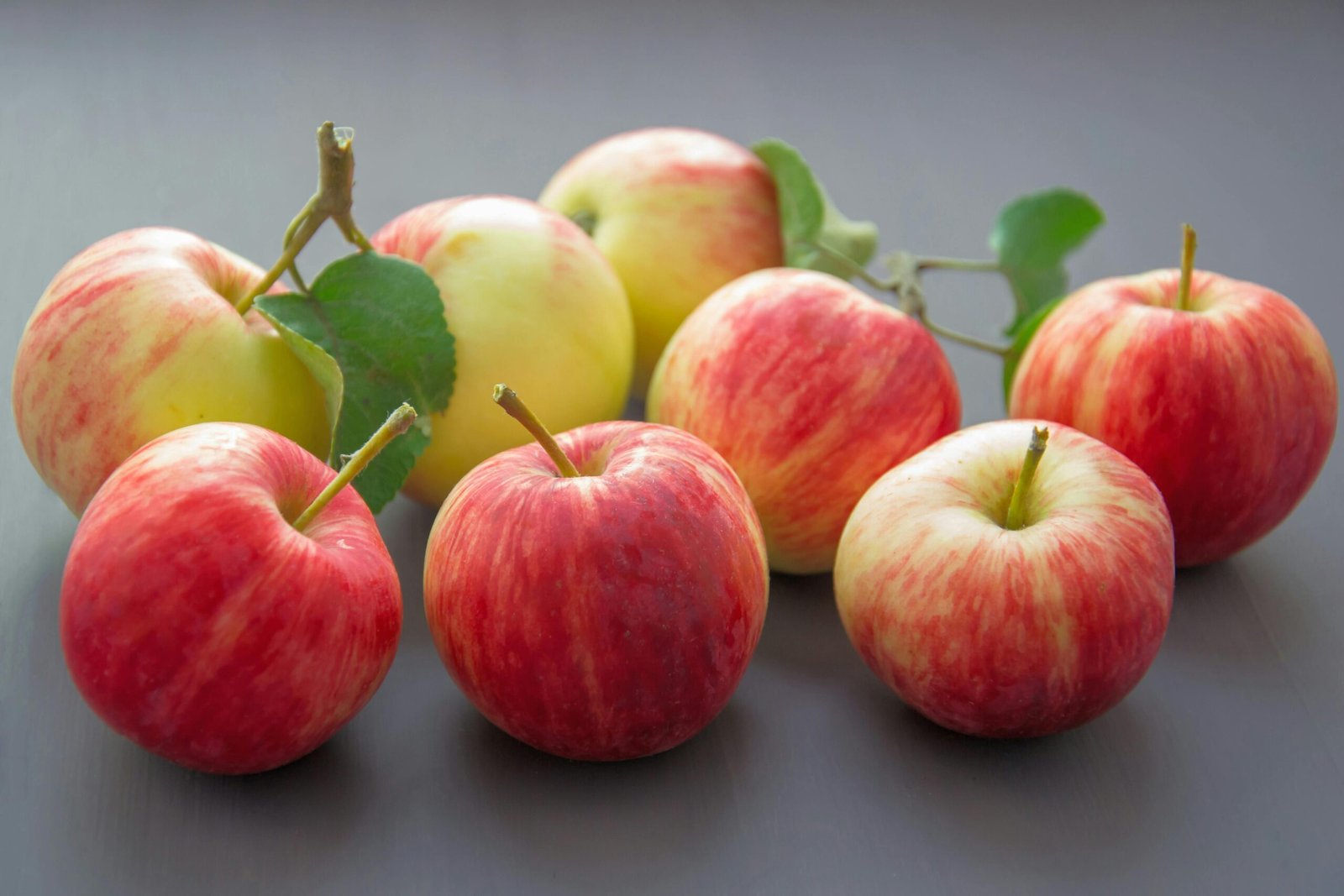
Apples are one of the most popular and widely consumed fruits around the world. Known for their crisp texture and a range of sweet to tart flavors, apples come in various colors, including red, green, and yellow, depending on the variety. They are not only delicious but also packed with nutrients, offering a range of health benefits. Here’s a closer look at apples and their nutritional and health benefits:
Nutritional Profile
Vitamins and Minerals: Apples are a good source of vitamin C, which is important for immune function, skin health, and iron absorption. They also contain small amounts of vitamin K, potassium, and various B vitamins.
Fiber: Apples are high in dietary fiber, with a medium sized apple providing about 4 grams of fiber, which is about 17% of the recommended daily intake. The fiber is found in the skin and the pulp.
Antioxidants: Apples are rich in antioxidants, including quercetin, catechin, and chlorogenic acid. These compounds help fight free radicals, reducing oxidative stress and lowering the risk of chronic diseases.
Health Benefits
Heart Health: The fiber and antioxidant content in apples can contribute to heart health by lowering blood pressure and reducing cholesterol levels. Eating apples has been associated with a lower risk of heart disease.
Weight Management: Due to their fiber content and low energy density, apples can be filling and help reduce overall calorie intake, supporting weight management.
Cancer Prevention: Some studies suggest that the consumption of apples may be linked to a reduced risk of certain types of cancer, such as lung and breast cancer, thanks to their antioxidant and anti-inflammatory properties.
Diabetes Prevention: The fiber in apples helps slow the absorption of sugar into the bloodstream, improving blood sugar control and reducing the risk of type 2 diabetes.
Gut Health: The type of fiber found in apples, pectin, is a prebiotic, meaning it feeds the good bacteria in your gut, promoting gut health and aiding digestion.
Varieties and Uses
There are thousands of apple varieties, with differences in taste, color, and texture. Some popular varieties include Granny Smith, Gala, Fuji, Honey crisp, and Red Delicious. Apples can be enjoyed fresh as a snack, cooked in dishes, baked in desserts, or even turned into apple cider vinegar.
Consumption Tips
Whole Fruit: Eating whole apples, with the skin, provides the most benefits since the skin contains a significant amount of the fiber and antioxidants.
Organic vs. Conventional: Apples are on the list of fruits and vegetables that are often found to have pesticide residues. Washing apples thoroughly or choosing organic varieties can help reduce exposure to pesticides.
In summary, apples are a nutritious fruit that offers numerous health benefits. Incorporating apples into your diet is a tasty way to improve overall health, from supporting heart and gut health to potentially reducing the risk of chronic diseases.
- Citrus Fruits: Oranges, grapefruits, lemons, and limes are rich in vitamin C and flavonoids, which can help improve heart health and reduce the risk of disease.
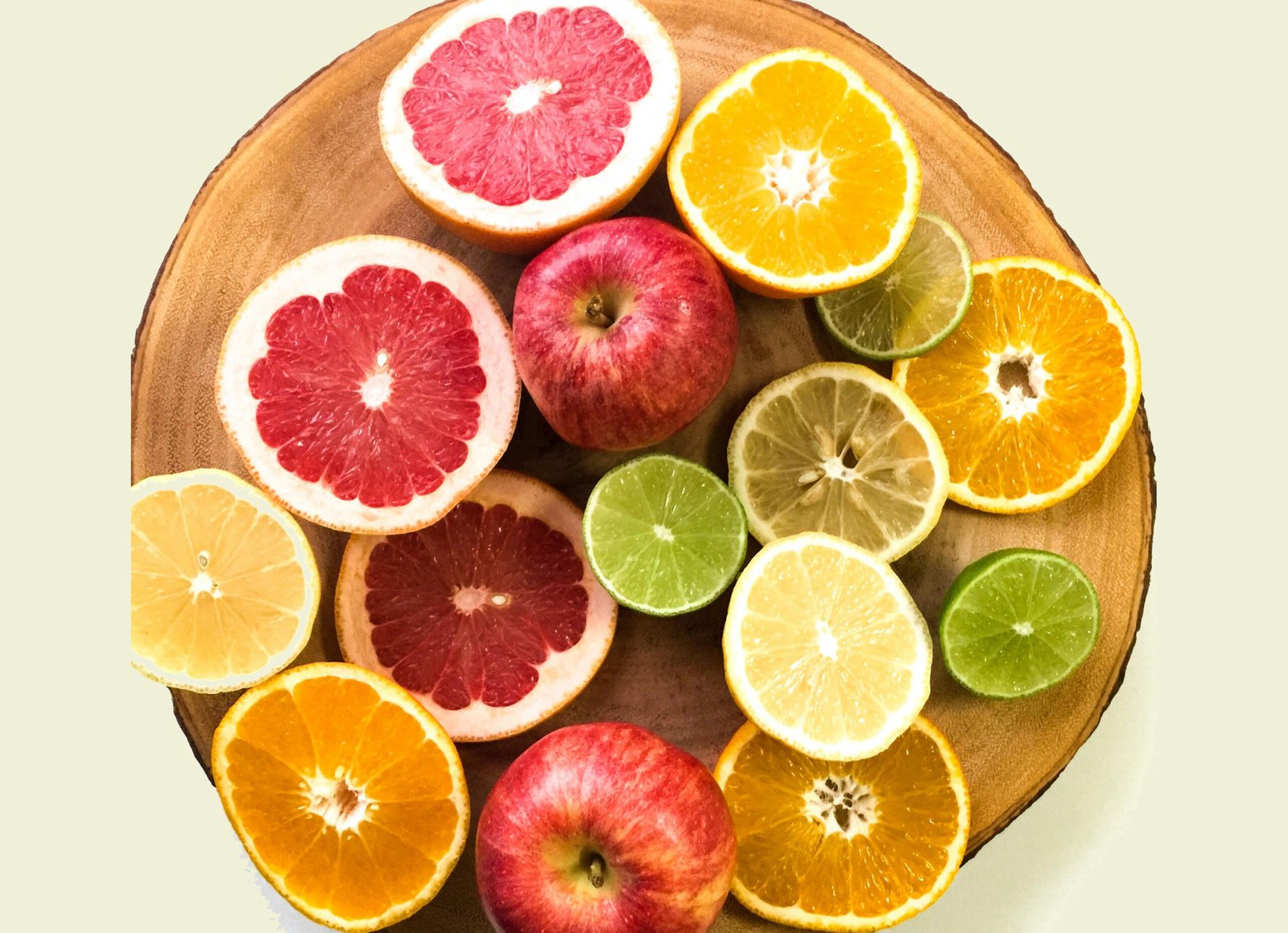
Citrus fruits are a group of fruits known for their bright colors, juicy segments, and refreshing flavors that range from sweet to tart. They belong to the genus Citrus in the Rutaceae family. Commonly consumed citrus fruits include oranges, lemons, limes, grapefruits, and tangerines, among others. These fruits are not only flavorful but also packed with vitamins, minerals, and antioxidants, offering numerous health benefits.
Nutritional Profile
Vitamin C: Citrus fruits are an excellent source of vitamin C, a powerful antioxidant that supports the immune system, skin health, and iron absorption.
Fiber: They are also a good source of dietary fiber, particularly in the pith (the white part between the flesh and the peel) and the pulp, which can aid in digestion and improve heart health.
Flavonoids: Citrus fruits contain various flavonoids, such as hesperidin and naringenin, which have antioxidant and anti-inflammatory properties.
Folate: Some citrus fruits, especially oranges, provide a significant amount of folate, a B vitamin important for cell division and DNA synthesis, making it particularly important for pregnant women.
Potassium: They offer potassium, which is vital for maintaining proper heart function, muscle contractions, and fluid balance.
Health Benefits
Boosts Immune Function: The high vitamin C content helps strengthen the immune system, making the body more resilient against infections.
Heart Health: The fiber, potassium, and antioxidant content in citrus fruits can help improve heart health by reducing blood pressure, cholesterol levels, and inflammation.
Weight Management: Being low in calories and high in water and fiber, citrus fruits can help promote fullness and reduce overall calorie intake, aiding in weight management.
Prevents Kidney Stones: The citrate content in citrus fruits can bind with calcium in the urine, potentially reducing the risk of forming calcium oxalate kidney stones.
Improves Digestive Health: The fiber in citrus fruits helps regulate the digestive system, preventing constipation and promoting gut health.
Skin Health: Vitamin C is crucial for collagen production, which supports skin elasticity and reduces the appearance of wrinkles.
Varieties and Uses
Citrus fruits are incredibly versatile and can be used in a wide range of culinary applications, from flavouring dishes and baked goods to being consumed fresh or as juices. Here are some common types:
Oranges: Often eaten fresh or squeezed for juice. Varieties include Valencia, Navel, and Blood oranges.
Lemons: Used for their juice and zest in cooking and baking, or as a garnish for drinks and dishes.
Limes: Similar to lemons, used in cooking, baking, and beverages. Key lime pie is a famous dessert made with limes.
Grapefruits: Eaten fresh, in salads, or juiced. Available in white, pink, and ruby varieties.
Tangerines: Sweeter and less acidic than oranges, easy to peel, and often eaten fresh.
Consumption Tips
To maximize health benefits, consume the whole fruit instead of just the juice to take advantage of the fiber content.
When using the zest, opt for organic fruits or wash them thoroughly to remove any pesticide residues or wax coatings.
Incorporating a variety of citrus fruits into your diet can contribute to overall health and provide a refreshing, flavourful boost to your meals and snacks.
- Bananas: Known for their high potassium content, bananas are great for heart health and blood pressure regulation. They’re also a good source of vitamins C and B6.

Bananas are among the most popular fruits worldwide. They come from the Musa genus of plants and are known for their soft, sweet flesh encased in a peel that can be easily removed. Bananas are not only delicious and convenient but also packed with essential nutrients and offer several health benefits.
Nutritional Profile
Potassium: Bananas are well-known for their high potassium content, which is essential for heart health, blood pressure regulation, and proper muscle and nerve function.
Vitamin B6: They are an excellent source of vitamin B6, which is important for brain health, metabolism, and creating neurotransmitters.
Vitamin C: While not as high in vitamin C as citrus fruits, bananas provide a good amount of this antioxidant, which is vital for immune function and skin health.
Magnesium: Bananas contain magnesium, which is important for heart health, bone strength, and metabolism.
Fiber: They are a good source of dietary fiber, including resistant starch and pectin, especially when green. These fibers can aid digestive health and provide a sense of fullness.
Energy: Bananas are a great source of quick release energy, thanks to their natural sugars and carbohydrates, making them a favorite among athletes.
Heart Health: The potassium in bananas is crucial for heart health and blood pressure control. A diet high in potassium can lower the risk of heart disease by reducing blood pressure and counteracting the negative effects of sodium.
Digestive Health: The fiber in bananas can help normalize bowel movements and maintain gastrointestinal health. The resistant starch in green bananas acts as a prebiotic, feeding the good bacteria in the gut.
Weight Management: Due to their fiber content and low to medium glycemic index, bananas can help you feel full longer and stabilize blood sugar levels, making them a good snack option for weight management.
Exercise and Recovery: The natural sugars and potassium in bananas make them an excellent snack for before or after exercise, providing energy and aiding in the recovery of muscle function and balance of water retention.
Varieties and Uses
There are many varieties of bananas, ranging from the common Cavendish bananas found in most supermarkets to smaller, sweeter types like the Lady Finger banana. Plantains are a starchy variety often used in cooking rather than eaten raw.
Bananas are versatile in the kitchen. They can be eaten raw as a snack, sliced into cereal or oatmeal, blended into smoothies, baked into bread, or used as a natural sweetener in various dishes. Even the peels have their uses, contributing nutrients to compost piles or serving as an ingredient in some culinary traditions.
Tips
Ripening: Bananas ripen naturally at room temperature. To speed up ripening, place them in a paper bag. To slow ripening, keep them in the refrigerator; the skin may darken, but the fruit inside remains unaffected for longer.
Storage: Keep unripe bananas at room temperature. Once they reach your preferred ripeness, you can store them in the refrigerator to maintain their state for a few more days.
In summary, bananas are a nutritious, energy rich fruit that offers numerous health benefits, making them a great addition to a balanced diet.
- Kiwi: Rich in vitamins C and K, potassium, and fiber, kiwi can help boost the immune system, support heart health, and aid digestion.

Kiwi, or kiwifruit, is a small, fuzzy, brown skinned fruit with bright green or golden flesh speckled with tiny black seeds. Originally from China, where it was known as the Chinese gooseberry, the fruit became popularly associated with New Zealand, which is responsible for its renaming and introduction to the global market. Kiwi is not only prized for its unique taste, which is sweet and tangy, but also for its remarkable nutritional profile and health benefits.
Nutritional Profile
Vitamin C: Kiwi is exceptionally high in vitamin C, even more so than oranges and lemons, making it excellent for boosting the immune system and skin health.
Vitamin K: It’s a good source of vitamin K, essential for blood clotting and bone health.
Vitamin E: Kiwi contains vitamin E, an antioxidant important for skin health and immune function that is relatively rare in fruits.
Fiber: Kiwis are high in dietary fiber, which aids in digestion and has been linked to reduced risk of heart disease.
Potassium: They provide a good amount of potassium, which is crucial for heart health, blood pressure regulation, and proper functioning of the muscles and nerves.
Antioxidants: Kiwi contains several antioxidants, including vitamin C, vitamin E, and polyphenols, which help to combat oxidative stress and may reduce the risk of chronic diseases such as heart disease and cancer.
Health Benefits
Digestive Health: The high fiber content helps maintain intestinal health, prevent constipation, and reduce the risk of gastrointestinal issues. Kiwi also contains an enzyme called actinide that can help break down protein, further aiding digestion.
Immune Support: The rich vitamin C content enhances the immune system, helping the body ward off infections and diseases.
Heart Health: Consuming kiwi can support heart health by lowering blood pressure, reducing blood clotting, and decreasing blood lipid levels.
Skin Health: The antioxidants in kiwi, especially vitamin C and E, can contribute to skin health by preventing skin damage and aging.
Sleep Improvement: Some studies suggest that kiwi consumption may improve sleep quality due to its high serotonin content, which is a brain chemical that helps regulate sleep.
Varieties and Uses
There are several varieties of kiwi, with the most common being the Hayward. The golden kiwi, which has a smooth, bronze skin and yellow flesh, is sweeter and more aromatic than the green variety. Kiwis can be eaten as they are after peeling, sliced into salads, blended into smoothies, or used as a topping for desserts and breakfast dishes. The kiwi’s vibrant green color and unique flavor make it a popular choice for adding a touch of exotic flair to various culinary creations.
Tips
Ripening: Kiwis ripen after being picked, so if they’re hard when you buy them, you can let them ripen at room temperature for a few days. Placing them next to bananas or apples can speed up the ripening process.
Consumption: The skin of the kiwi is edible and contains high fiber, though many people prefer to peel it due to its fuzzy texture.
In summary, kiwi is a nutrient rich fruit that offers numerous health benefits, from improving digestive health to boosting the immune system. Its unique taste and versatility make it a delightful addition to a healthy diet.
- Pomegranates: Packed with antioxidants, fiber, and vitamins, pomegranates are linked to reduced inflammation, cancer prevention, and improved heart health.
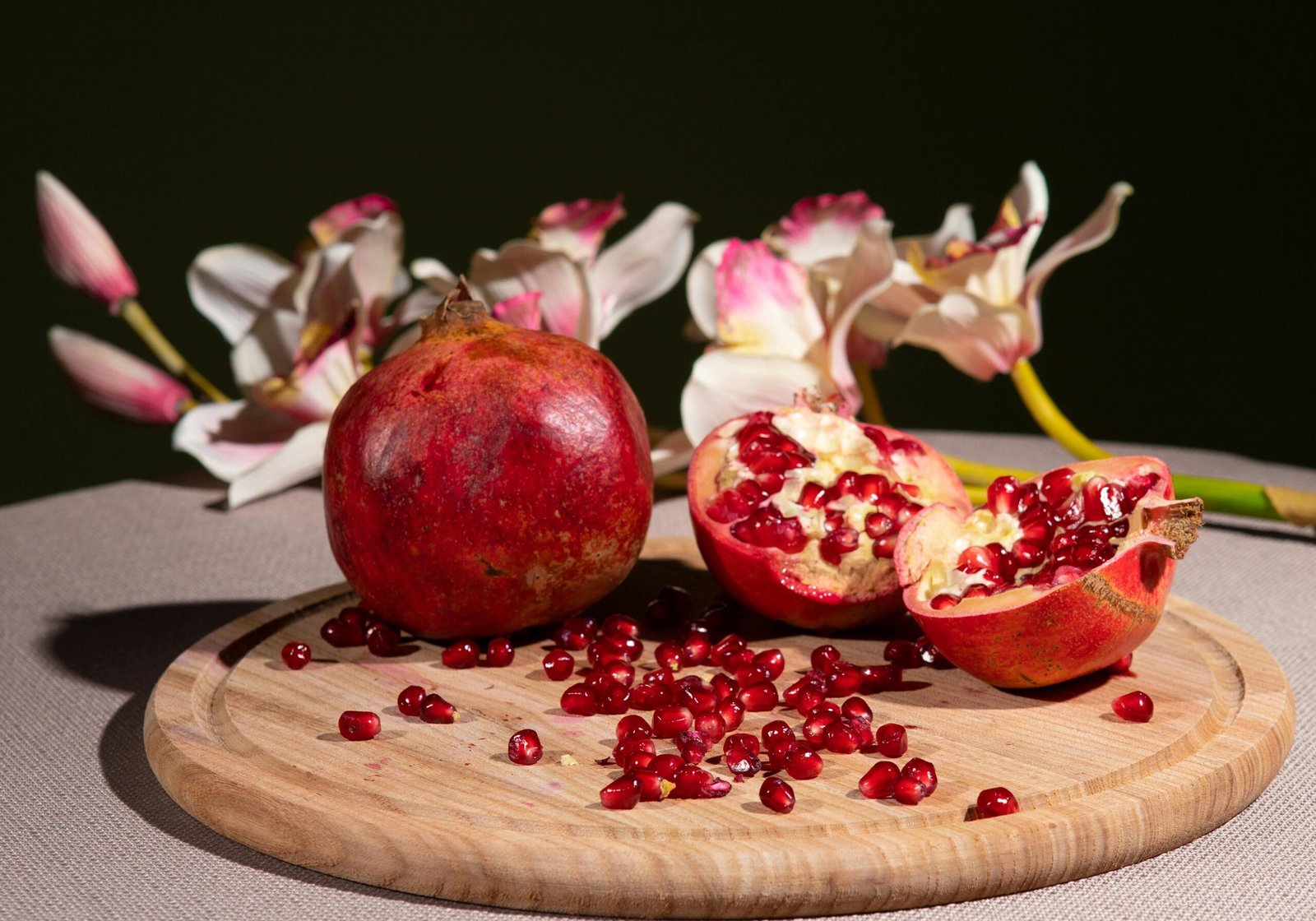
Pomegranates are a highly nutritious fruit known for their sweet and tart flavor, which comes from the arils inside. These arils are the edible part of the fruit, consisting of juicy flesh and a small, edible seed. The fruit is encased in a thick, inedible husk. Pomegranates are not only delicious but also packed with a variety of nutrients and bioactive plant compounds that are beneficial for health.
Nutritional Profile
Vitamins and Minerals: Pomegranates are rich in vitamin C, providing about 30% of the daily value per 100 grams. They also offer good amounts of vitamin K, folate, and potassium.
Antioxidants: One of the most notable health benefits of pomegranates is their high antioxidant content, particularly punicalagins and anthocyanins, which are responsible for the fruit’s vibrant red color.
Fiber: The seeds provide a decent amount of dietary fiber, which is beneficial for digestive health.
Health Benefits
Heart Health: Consuming pomegranates has been linked to improved heart health. Studies suggest that they can lower blood pressure, reduce cholesterol levels, and decrease the risk of atherosclerosis.
Cancer Prevention: The antioxidants in pomegranates have been studied for their potential to combat cancer, with some research suggesting they can help reduce the risk of prostate and breast cancer.
Anti-inflammatory Effects: Pomegranates have strong anti-inflammatory properties, largely due to their high concentration of antioxidant compounds. Chronic inflammation is a root cause of many serious diseases, including cancer, heart disease, type 2 diabetes, Alzheimer’s disease, and even obesity.
Joint Pain Relief: The anti-inflammatory properties of pomegranates may also help treat arthritis and joint pain. Some studies have shown that pomegranate extract can block enzymes known to damage joints in people with osteoarthritis.
Improved Memory: Some studies have shown that pomegranates can improve memory and cognitive function, possibly due to their antioxidant content.
Consumption and Use
Pomegranate arils can be eaten fresh or used as a garnish or ingredient in salads, dishes, and desserts. Pomegranate juice is another popular way to consume the fruit, though it’s important to note that the juice can be high in sugar. When choosing pomegranate juice, opt for pure, 100% juice without added sugars.
Tips
Opening a Pomegranate: To easily access the arils, cut the crown off the fruit, score it lightly in quarters, break it open over a bowl of water, and then gently release the arils with your fingers. The arils will sink, and the inedible white membrane will float, making them easy to separate.
Staining: Be cautious, as pomegranate juice can stain. Wearing an apron or clothing that you don’t mind getting stained when handling pomegranates is a good idea.
Pomegranates are a delicious and healthy addition to any diet, offering a wealth of nutrients and health benefits. Whether consumed as fresh arils, juice, or in cooking, they can contribute to overall health and wellbeing.
- Avocados: Unlike most fruits, avocados are high in healthy fats, particularly monounsaturated fat, which is good for heart health. They’re also loaded with fiber, potassium, and vitamins C, E, and K.

Avocados are a unique and highly nutritious fruit, primarily grown in warm climates. Their rich, creamy texture and subtle flavor make them a favorite for many and a staple in various cuisines worldwide, especially in Mexican and Central American dishes. Unlike most fruits that are high in carbohydrates, avocados are high in healthy fats, making them a nutrient dense food with a range of health benefits.
Nutritional Profile
Healthy Fats: Avocados are rich in monounsaturated fats, particularly oleic acid, which is associated with reduced inflammation and has been shown to have beneficial effects on genes linked to cancer.
Fiber: They are a good source of dietary fiber, which is important for digestive health and can help reduce blood sugar spikes.
Vitamins and Minerals: Avocados are packed with various vitamins and minerals, including vitamin K, vitamin E, vitamin C, potassium (more than bananas), and folate, among others.
Antioxidants: They contain a wealth of antioxidants, including lutein and zeaxanthin, which are incredibly important for eye health and can reduce the risk of macular degeneration and cataracts.
Health Benefits
Weight Management: Although high in calories, avocados can be a valuable part of a weight management diet. Their fiber and fat content can help you feel full and satisfied, potentially reducing overall calorie intake.
Improved Digestion: The fiber in avocados not only helps maintain a healthy digestive tract but also aids in preventing constipation.
Nutrient Absorption: Consuming avocados can help increase the absorption of fat-soluble vitamins (A, D, E, K) from other foods, making them a great companion to vegetables in salads and dishes.
Skin and Hair Health: The healthy fats in avocados are beneficial for your skin and hair, keeping them nourished and moisturized.
Consumption and Uses
Avocados are incredibly versatile in the kitchen. They can be eaten raw, added to salads and sandwiches, or mashed and spread on toast. Avocado is also the main ingredient in guacamole, a popular Mexican dip. Due to their creamy texture, they can be used as a substitute for butter in baking or as a base for smoothies, adding richness and nutritional value.
Tips
Ripening: If avocados are hard when you buy them, let them ripen at room temperature. Placing them in a paper bag can speed up the ripening process.
Storage: Once ripe, avocados can be stored in the refrigerator to slow down further ripening. If you’ve cut an avocado and want to save the rest for later, keep the pit in the unused half, squeeze some lemon or lime juice over the flesh, and wrap it tightly in plastic wrap to minimize browning.
Avocados are a delicious and nutrient rich food that can contribute to a healthy diet. Their unique profile of fats, fiber, and vitamins supports heart health, digestive health, and much more, making them a valuable addition to your dietary routine.
- Papayas: A great source of vitamin C, vitamin A (from betacarotene), and digestive enzymes like papain, papayas can improve digestive health and may have anti-inflammatory effects.

Papayas are tropical fruits known for their vibrant orange color, sweet taste, and numerous health benefits. They originate from Central America but are now grown in many tropical regions around the world. Papayas are not only delicious but also rich in vitamins, minerals, and antioxidants, making them a great addition to a healthy diet.
Nutritional Profile
Vitamins: Papayas are an excellent source of vitamin C, providing more than the daily recommended amount in a single medium fruit. They also contain good amounts of vitamin A (from betacarotene), vitamin E, and folate.
Enzymes: Papaya contains papain, a unique enzyme that aids in the digestion of proteins. Papain can also be used externally as a treatment for wounds or as a meat tenderizer.
Fiber: They are a good source of dietary fiber, which helps promote a healthy digestive tract.
Antioxidants: Papayas are rich in antioxidants, such as carotenoids and flavonoids, that help reduce oxidative stress and lower the risk of several diseases.
Health Benefits
Digestive Health: The papain enzyme in papayas helps improve digestion by breaking down proteins into their building blocks, making them easier to digest. The fiber content also aids in regulating bowel movements.
Anti-inflammatory Properties: The chymopapain and papain enzymes have been shown to reduce inflammation in the body, which can help alleviate symptoms of arthritis and other inflammatory conditions.
Heart Health: The fiber, potassium, and vitamins in papayas help protect against heart disease. The potassium in papayas helps manage blood pressure levels, while the antioxidants prevent cholesterol oxidation in the arteries.
Skin Health: The vitamin C and lycopene in papayas protect skin and may help reduce signs of aging. Papaya can also be used topically as a face mask to exfoliate and moisturize the skin.
Immune Support: The high content of vitamin C and vitamin A in papayas boosts the immune system, helping to reduce illness duration and severity.
Consumption and Uses
Papayas can be eaten fresh, added to salads, or blended into smoothies. They can also be used in cooking, especially in tropical dishes. The ripe fruit should have a yellow to orange skin, and it should give slightly under pressure, indicating it is ready to eat. The seeds are edible and have a slightly peppery flavor but are usually discarded.
Tips
Preparation: To eat a papaya, cut it lengthwise, scoop out the seeds, and then use a spoon to eat the flesh directly from the skin or cut it into pieces.
Ripening: If a papaya is not yet ripe, you can leave it at room temperature for a few days until it softens and the skin turns more yellow or orange.
Storage: Once ripe, papayas can be stored in the refrigerator to slow down the ripening process and extend their shelf life.
In summary, papayas are a nutritious and versatile fruit that offers a wide array of health benefits, from improving digestion and reducing inflammation to boosting heart and skin health. Their sweet taste and tropical flavor make them a delicious addition to a variety of dishes.
- Mangoes: Rich in vitamins A and C, mangoes also offer a good amount of fiber and over a dozen types of polyphenols, including mangiferin, which has strong antioxidant properties.

Mangoes often referred to as “the king of fruits,” are one of the most popular, nutritionally rich fruits with a unique flavor, fragrance, taste, and health promoting qualities. Native to South Asia, mangoes have been cultivated for thousands of years. The tree belongs to the family Anacardiaceae, which also includes cashews and pistachios. Mangoes are widely grown in tropical and subtropical regions around the world and come in various sizes, shapes, and colors including yellow, orange, red, and green.
Nutritional Profile
Vitamins and Minerals: Mangoes are a great source of vitamins A and C, which are important for immune function and skin health. They also provide vitamin E, K, and several B vitamins, as well as potassium, magnesium, and copper.
Antioxidants: They are rich in antioxidants such as mangiferin, quercetin, betacarotene, and astragalin. These compounds help protect the body against oxidative stress linked to many chronic diseases.
Fiber: Mangoes contain a decent amount of dietary fiber, beneficial for digestive health and can help prevent constipation.
Health Benefits
Boosts Immunity: The high levels of vitamin C and vitamin A in mangoes, along with 25 different kinds of carotenoids, keep your immune system healthy and strong.
Promotes Eye Health: Vitamin A and beta-carotene in mangoes help boost eye health, prevent night blindness, and dry eyes.
Improves Digestive Health: The enzymes and fiber in mangoes help break down protein content in the body, improving digestion and gut health.
Supports Heart Health: Mangoes contain nutrients like potassium and magnesium that support healthy heart function. The mangiferin in mangoes may also help protect heart cells against inflammation, oxidative stress, and apoptosis (cell death).
Helps Lower Cholesterol: The high levels of fiber, pectin, and vitamin C help lower serum cholesterol levels, specifically Low-density Lipoprotein (the bad stuff).
Skin and Hair Health: Vitamins A and C are crucial for skin and hair health. Vitamin C is involved in collagen production, and Vitamin A helps fight acne and promotes healthy hair.
Consumption and Uses
Mangoes can be enjoyed in numerous ways, both ripe and unripe. Ripe mangoes are sweet and can be eaten fresh or used in a variety of dishes, including salads, smoothies, yogurts, and desserts. Unripe mangoes have a tart flavor and are often used in pickles, chutneys, and salads. Mango pulp and juice are also popular in cooking and baking for their sweet, tropical flavor.
Tips
Ripening: If mangoes are not yet ripe, storing them at room temperature can help them ripen. Placing them in a paper bag can speed up the ripening process.
Storage: Once ripe, mangoes can be stored in the refrigerator to slow further ripening. They can also be sliced and frozen for long-term storage or smoothie use.
Mangoes, with their rich nutritional profile and potential health benefits, are a delicious way to enhance the quality of your diet. Whether eaten fresh, added to dishes, or blended into drinks, mangoes can provide a tropical flavor boost along with a host of vitamins, minerals, and antioxidants.
10. Watermelon: High in vitamins A and C, watermelon is also rich in antioxidants, particularly lycopene, which has been linked to heart health and cancer prevention.
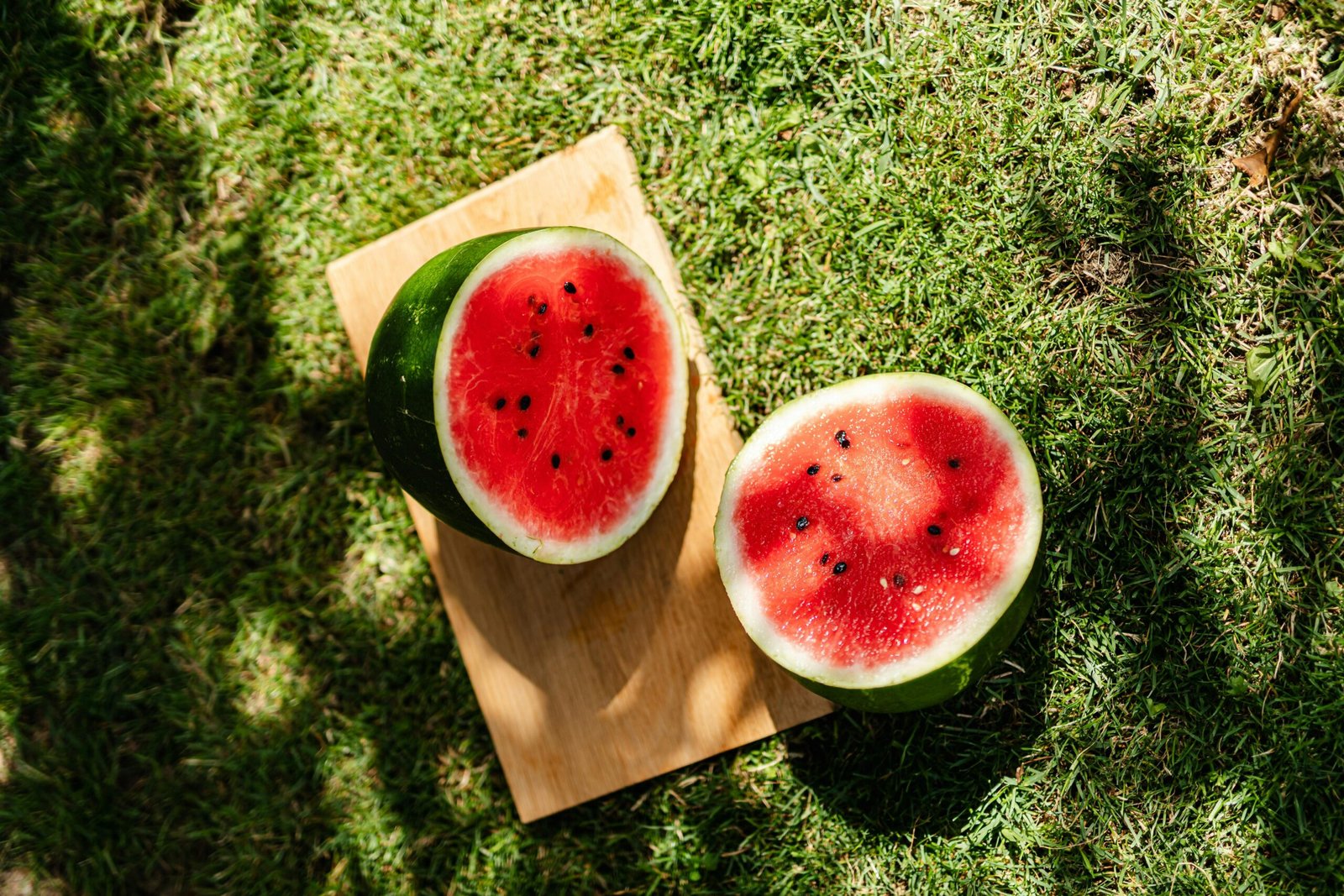
Watermelon is a popular, refreshing summer fruit known for its high water content, sweet taste, and nutritional benefits. Belonging to the Cucurbitaceae family, it is related to cucumbers, pumpkins, and squash. Watermelon is not only a delicious low calorie treat but also packed with important vitamins and minerals, making it a healthy choice for hydration and nutrition.
Nutritional Profile
Hydration: Watermelon is made up of about 92% water, making it excellent for hydration, especially during hot weather.
Vitamins and Minerals: It is a good source of vitamin C, which is important for immune function, skin health, and wound healing. Watermelon also provides vitamin A, B vitamins, potassium, and magnesium.
Antioxidants: Watermelon is rich in antioxidants, including lycopene, which gives the fruit its red color. Lycopene has been linked to heart health, cancer prevention, and protection against sunburn.
Amino Acids: It contains citrulline, an amino acid that may increase nitric oxide levels in the body, helping your blood vessels expand and lowering blood pressure.
Health Benefits
Heart Health: The lycopene in watermelon can help lower cholesterol and blood pressure. It can also help prevent oxidative damage to cholesterol.
Hydration: Due to its high water content, watermelon is excellent for staying hydrated. Proper hydration is vital for maintaining healthy digestion, skin health, and kidney function.
Reduced Muscle Soreness: Citrulline, an amino acid in watermelon, may reduce muscle soreness. It’s also available as a supplement. Drinking watermelon juice before an intense workout can reduce nextday muscle soreness.
Anti-inflammatory Properties: Watermelon has anti-inflammatory properties thanks to its lycopene content and other compounds that can help reduce inflammation and oxidative damage.
Digestive Health: The water and fiber in watermelon help promote a healthy digestive tract, aiding in regular bowel movements and preventing constipation.
Watermelon can be eaten fresh and is also popularly used in salads, juices, and smoothies. It can be a refreshing addition to fruit salads or served as a dessert, especially when chilled. Watermelon rinds and seeds are also edible; the rinds can be pickled, and the seeds can be roasted for a nutritious snack.
Tips
Choosing a Watermelon: Look for a watermelon that is firm, heavy for its size, and has a yellow spot from where it sat on the ground and ripened in the sun.
Storage: Whole watermelons can be stored at room temperature before cutting. Once cut, watermelon should be refrigerated to keep it fresh and prevent bacterial growth.
Preparation: Watermelon can be sliced, cubed, or scooped into balls. It’s also a great addition to drinks and can be blended into a refreshing juice or smoothie.
Watermelon is a versatile, delicious fruit that offers numerous health benefits. Its high water content makes it perfect for hydration, while its nutrients and antioxidants support heart health, reduce inflammation, and provide other health benefits. Whether you’re looking for a sweet snack or a hydrating drink, watermelon is a fantastic choice.
11. Pineapple: Besides being high in vitamin C and manganese, pineapple contains bromelain, an enzyme that may help with digestion and reduce inflammation.

Pineapple is a tropical fruit that is cherished for its unique taste, which is a perfect blend of sweet and tart flavors. It is not only delicious but also packed with nutrients, vitamins, and enzymes that can aid in digestion and boost overall health. Native to South America, pineapples have become a staple fruit across the world, especially in tropical and subtropical regions.
Nutritional Profile
Vitamins and Minerals: Pineapples are rich in vitamin C, which supports the immune system, aids in the absorption of iron from the diet, and contributes to skin health by helping to produce collagen. They also provide a good amount of manganese, a mineral essential for growth, metabolism, and antioxidant defences. Additionally, pineapples contain vitamins A and K, phosphorus, zinc, and calcium.
Bromelain: One of the most notable compounds in pineapple is bromelain, an enzyme complex that breaks down protein. This can aid in digestion, especially of protein rich foods, and has been studied for its anti-inflammatory and analgesic properties.
Antioxidants: Pineapples are packed with antioxidants, such as flavonoids and phenolic acids, which combat oxidative stress and may reduce the risk of chronic diseases like heart disease, diabetes, and certain cancers.
Health Benefits
Digestive Health: Thanks to bromelain’s protein digesting properties, eating pineapple can help improve digestion and reduce bloating and constipation.
Anti-inflammatory Effects: Bromelain may also help reduce inflammation, alleviate symptoms of arthritis, and expedite recovery from injuries and surgery.
Immune Support and Disease Prevention: The high vitamin C content boosts the immune system, helping the body combat infections. The antioxidants in pineapple can help reduce the risk of chronic diseases by neutralizing harmful free radicals.
Supports Recovery: Bromelain’s anti-inflammatory and analgesic properties may aid in the recovery of sports injuries and postoperative recovery by reducing bruising, swelling, and pain.
Consumption and Uses
Pineapple can be consumed fresh, cooked, juiced, or preserved. It is a popular ingredient in a wide variety of dishes, from sweet desserts and smoothies to savory dishes like stirfries, grilled meats, and pizzas. The core, often discarded due to its fibrous texture, is actually edible and contains high concentrations of bromelain.
Tips
Choosing and Storing: Select pineapples with green leaves, a firm shell, and a sweet smell at the base. It should have a slight give when squeezed gently. Pineapples stop ripening as soon as they are harvested, so choose one that’s already ripe. Store it in the refrigerator if you’re not eating it immediately to keep it fresh longer.
Preparation: To prepare a pineapple, slice off the top and bottom, stand it upright, and cut away the skin in strips. Then, remove any remaining “eyes” with a knife or peeler, and slice or cube as desired.
Pineapple is a versatile fruit that offers a wealth of nutritional benefits, making it a great addition to a healthy diet. Whether you’re enjoying it on its own, in a fruit salad, or as part of a savory dish, its tropical flavor is sure to delight.
12. Cherries: Cherries are rich in antioxidants, including anthocyanins and cyanidin, which may help reduce inflammation and mitigate the effects of chronic diseases.

Cherries are a beloved fruit known for their vibrant color, juicy texture, and sweet or tart flavor, depending on the variety. They belong to the genus Prunus, which also includes almonds, peaches, and plums. Cherries are typically classified into two main types: sweet cherries (Prunus avium) and tart or sour cherries (Prunus cerasus). Sweet cherries are often eaten fresh, while tart cherries are commonly used in cooking and baking, offering a distinctively sharp flavor that complements sweet dishes well.
Nutritional Profile
Vitamins and Minerals: Cherries are a good source of vitamin C, which is important for immune function, skin health, and collagen production. They also provide potassium, which helps control blood pressure and muscle contractions, as well as fiber, vitamin K, and manganese.
Antioxidants: Both sweet and tart cherries are rich in antioxidants, including anthocyanins and cyanidin, which give them their deep red color. These compounds have anti-inflammatory properties and may help reduce the risk of chronic diseases.
Melatonin: Tart cherries, in particular, contain melatonin, a hormone that regulates sleep cycles, which may help improve sleep quality.
Health Benefits
Heart Health: The antioxidants in cherries can help reduce inflammation and lower the risk of heart disease by protecting against oxidative stress and reducing factors like cholesterol levels and blood pressure.
Exercise Recovery: Consuming tart cherry juice has been shown to reduce muscle soreness and improve recovery after strenuous exercise, thanks to its anti-inflammatory effects and antioxidant content.
Improved Sleep: The melatonin content in tart cherries may help improve the quality and duration of sleep, making cherry juice a popular natural remedy for sleep problems.
Joint Pain and Gout: The anti-inflammatory properties of cherries may also benefit those suffering from arthritis and gout by reducing pain and inflammation.
Consumption and Uses
Cherries can be enjoyed fresh, dried, frozen, or as juice. Fresh cherries make a delicious and healthy snack on their own, but they can also be added to salads, yogurt, oatmeal, or desserts for a burst of flavor. Tart cherry juice is a popular beverage for its health benefits, particularly for exercise recovery and sleep improvement. Cherries can also be used in cooking and baking, adding a sweet or tart flavor to pies, tarts, jams, and sauces.
Tips
Choosing and Storing: Look for cherries that are firm, plump, and have a shiny skin with a deep, uniform color. Avoid cherries that are soft, shriveled, or have blemishes. Fresh cherries should be stored in the refrigerator and washed just before eating.
Preparation: To pit cherries, you can use a cherry pitter or a simple trick with a sturdy straw or a paperclip to push the pit out.
Cherries offer a wealth of health benefits in addition to their delicious taste. Whether you prefer them sweet or tart, incorporating cherries into your diet can contribute to better health and wellbeing.
Including a variety of these fruits in your diet can contribute to overall health and help prevent a range of chronic diseases. It’s best to consume fruits whole to benefit from their fiber content, which can help slow the absorption of sugar and improve digestive health.
Fruit juice vs Fruit: What is better for you?

When it comes to choosing between fruit juice and whole fruit, whole fruits are generally considered the better option for most people due to their nutritional composition and health benefits. Here are some key points to consider in the comparison between fruit juice and whole fruit:
Fiber Content
Whole Fruit: Contains dietary fiber, which is beneficial for digestive health. Fiber helps to slow down the absorption of sugar, reducing spikes in blood glucose levels. It also aids in maintaining a healthy gut micro-biota and can contribute to feelings of fullness, potentially helping with weight management.
Fruit Juice: Most of the fiber is removed during the juicing process. Lack of fiber means that the natural sugars in fruit juice can be absorbed more quickly, leading to faster spikes in blood sugar levels.
Nutritional Density
Whole Fruit: Along with fiber, whole fruits contain a wide range of vitamins, minerals, and antioxidants. The act of chewing also contributes to satiety, helping you feel more satisfied and less likely to over consume calories.
Fruit Juice: While fruit juice can still be a good source of vitamins and minerals (such as vitamin C and potassium), the concentration of sugars is higher compared to whole fruit. Some vitamins and phytonutrients may be lost during processing, and without the fiber, it’s easier to consume a larger amount of calories quickly.
Caloric Intake
Whole Fruit: The fiber in whole fruits adds bulk to your diet, which fills you up and helps control your appetite. This makes it easier to manage your caloric intake.
Fruit Juice: It’s easy to consume a lot of calories quickly with fruit juice because it lacks fiber and is more calorie dense than whole fruit. For instance, it takes several oranges to make a single glass of orange juice, concentrating the calories and sugar while reducing the dietary fiber.
Whole Fruit: The fiber in whole fruit slows down the absorption of sugar, mitigating spikes in blood glucose and insulin levels.
Fruit Juice: The higher concentration of fructose (fruit sugar) and the absence of fiber can lead to more rapid increases in blood sugar levels, which can be a concern for people with diabetes or those trying to manage their blood sugar levels.
Overall Health Impact
Consuming whole fruits is linked to a reduced risk of many health conditions, including heart disease, diabetes, and obesity. While fruit juice can still be part of a healthy diet, it should be consumed in moderation. The American Academy of Pediatrics recommends limiting fruit juice intake in children and encourages eating whole fruits instead.
Conclusion: While fruit juice can be enjoyed in moderation as part of a balanced diet, whole fruits offer more significant health benefits and are generally a better choice for most people. If you do choose to drink fruit juice, opt for 100% fruit juice without added sugars and consider diluting it with water or seltzer to reduce sugar intake.
Are there any unhealthy fruits?

The concept of “unhealthy” fruits is somewhat misleading, as all fruits offer nutritional benefits, including essential vitamins, minerals, antioxidants, and fiber. However, some fruits might be less beneficial for certain individuals depending on specific health goals or conditions. It’s more about the context of consumption and individual health considerations than the fruit itself being “unhealthy.” Here are a few considerations:
High Sugar Content
Fruits with High Natural Sugars: Fruits like mangoes, grapes, cherries, and bananas have higher sugar content compared to other fruits. While they are healthy in moderation, individuals with diabetes or those watching their blood sugar levels might need to consume them in controlled amounts.
Caloric Density
Dried Fruits: Dried fruits are more nutrient and calorie dense than their fresh counterparts. For example, raisins contain more calories and sugars gram for gram than grapes. They can be easy to overeat, leading to excess calorie consumption, which might not align with weight management goals.
Glycemic Index (GI)
High Glycemic Index Fruits: Some fruits have a higher glycemic index, meaning they can raise blood sugar levels more quickly. Watermelon and pineapple have higher GI values, so individuals looking to manage blood sugar levels might need to eat them in moderation.
Fruit Products with Added Sugars
Canned Fruits and Fruit Snacks: Some processed fruit products, like canned fruits in syrup or fruit snacks, often contain added sugars or sweeteners, making them less healthy than their fresh or frozen counterparts.
Individual Allergies and Health Conditions
Allergies: Certain fruits can trigger allergic reactions in some individuals. For example, some people might be allergic to strawberries, kiwis, or pineapples.
Fructose Intolerance: Individuals with fructose intolerance might need to limit their intake of certain fruits to avoid digestive issues.
Oral Allergy Syndrome (OAS): Some individuals may experience OAS, a type of food allergy that causes immediate allergic reactions in the mouth and throat after eating certain fruits.
Moderation is Key
For most people, the variety and moderation of fruit consumption are crucial. Eating a wide range of fruits can provide a broad spectrum of nutrients and minimize the potential negative effects of consuming too much of any one type.
Conclusion
No fruit is inherently “unhealthy,” but some fruits may be less suitable for individuals with specific dietary needs, health conditions, or goals. It’s important to consider personal health factors when choosing which fruits to incorporate into your diet and to consume a variety of fruits to ensure a broad intake of nutrients.
